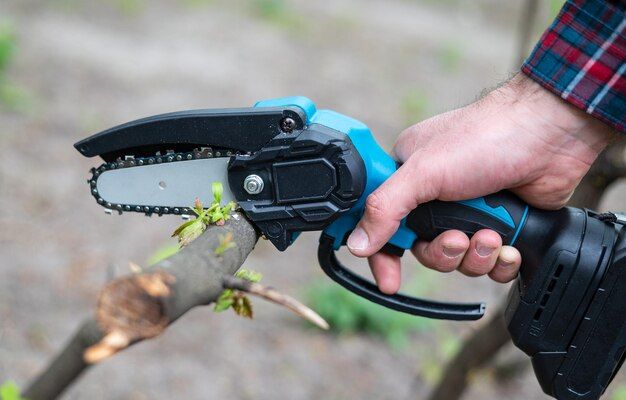Battery-powered chainsaws are becoming an increasingly popular option for homeowners and DIYers looking for a cordless, portable alternative to gas-powered chainsaws. But are they actually worth the investment? There are pros and cons to consider when deciding between battery versus gas chainsaws.
Page Contents
The pros of battery chainsaws
There are several advantages that battery-powered chainsaws have over traditional gas models:
- Portability – Cordless chainsaws are much easier to move around since you don’t have to worry about staying near an outlet or dragging around a power cord. This makes them ideal for quick jobs around different areas of your property.
- Convenience – With a battery chainsaw, there is no messy fuel to deal with. You don’t have to mix gas and oil, deal with spills or leaks, or remember to drain the tank for storage. Simply charge up the battery and go.
- Lower noise – Battery chainsaws operate much more quietly than gas models, making them better for use around neighborhoods or to avoid disturbing others.
- Environmentally friendly – Battery models are emissions free, so they don’t create the air or noise pollution that gas chainsaws do.
- Low maintenance – Cordless chainsaws don’t have complex fuel systems that need regular maintenance and cleaning.
- Safety – The lack of fuel means there’s no risk of flammable liquids on a hot engine. Battery packs are sealed and safe.
For casual homeowners who only need a chainsaw occasionally, the convenience and simplicity of a cordless model can be appealing.
The cons of battery chainsaws
However, there are some downsides to battery-powered chainsaws to be aware of:
- Limited runtime – While gas chainsaws can run continuously as long as there is fuel, battery life is finite. Runtime is typically 30-60 minutes per charge depending on use.
- Longer recharge times – It can take 2-3 hours to fully recharge some battery packs, reducing productivity if you run out mid-job.
- Reduced power – Battery chainsaws universally have less power than comparable gas models. They may struggle with larger cuts or thick wood.
- Weather limitations – Colder weather saps battery performance. Gas models are not impacted by temperatures.
- Upfront cost – Quality battery chainsaws sell for $200-$400, more expensive than some gas options.
- Ongoing battery costs – Expect to buy a replacement battery every 3-5 years.
For professionals or avid users who need a chainsaw for heavy duty use, the limitations of batteries may be too restrictive.
Key factors to consider
When deciding between a battery or gas chainsaw, keep the following factors in mind:
- Power output – Gas chainsaws are rated by engine size/cubic centimeters (cc). More cc’s equals more cutting power. Battery models use voltage as the power metric, typically ranging from 40V to 80V.
- Bar length – The bar determines cutting capacity. Battery saws typically max out around 16 inches. Gas models can accommodate 18-24 inch bars for bigger cuts.
- Run time – Gas chainsaws can run for 2-3 hours on a tank. Expect 30-60 minutes from a charged battery.
- Charge time – Most batteries take 60-180 minutes to fully recharge. Fast chargers are available for some models.
- Weight – Battery saws weigh 8-12 lbs on average. Comparable gas models are 15-18 lbs.
- Weather resistance – Gas engines function fine in cold weather. Battery output declines below 40°F.
Consider your typical cutting tasks and needs to pick the power and run time that makes sense.
Best battery chainsaws
These top-rated cordless chainsaws provide the best balance of power, run time and overall value:
| Model | Power | Bar Length | Run Time | Weight |
|---|---|---|---|---|
| DeWalt 60V MAX | 60V | 16″ | 45 min | 13 lbs |
| Makita XCU03PT | 36V | 14″ | 45 min | 10 lbs |
| Greenworks PRO 80V | 80V | 16″ | 60 min | 12 lbs |
| EGO Power+ CS1800 | 56V | 18″ | 45 min | 12 lbs |
Gas chainsaw alternative
For those who need maximum power and run time, gas chainsaws are still the best option. This pro-grade Husqvarna model delivers excellent performance:
| Model | Engine | Bar Length | Power Output | Run Time | Weight |
|---|---|---|---|---|---|
| Husqvarna 460 Rancher | 60.3cc | 24″ | 3.62 HP | 12 hrs per tank | 18 lbs |
Bottom line
For occasional light-duty cutting, battery chainsaws provide cordless convenience and quiet, emissions-free operation. But for heavy use or large cuts, gas-powered models still deliver superior runtime and power. Consider your specific needs and uses to decide which is the better fit.
Conclusion
Battery chainsaws have come a long way in performance and can now handle many basic property maintenance needs. Models from leading brands like DeWalt, Makita and EGO offer impressive cutting capacity and run times of 30-60 minutes. However, they still can’t match the power and durability of gas chainsaws for demanding tasks. For professional use or large properties, gas-powered models are still the best choice. But battery technology continues to improve and may someday close the gap in capabilities.
